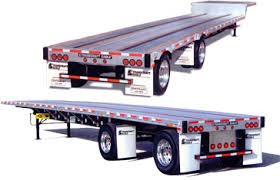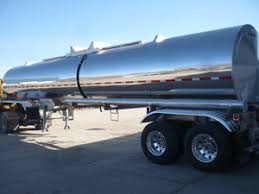Yesterday, we talked about all the different types of trucks and brands of trucks and cars. The picture above is a collection of logos of all kinds of different cars! Interesting, isn't it?
Today, I'll show you different trailers out there. Ready?


So, above are two similar trailers. The one on the left is a dry van. The one on the right is a refrigerated van trailer. The one on the left will haul things that have to stay dry but temperature isn't a problem. Things like wood, furniture, carpet, paper, electronics, and other dry goods The goods in these are usually on wood pallets and shrink wrapped. Sometimes in boxes. The one on the right will haul things that need to be kept at a certain temperature. Things like groceries, produce, ice cream, meat, chocolate or anything that has to be kept at just the right temperature. The black thing up front has a small diesel engine and a big refrigeration unit attached. There is a small diesel fuel tank underneath to keep fuel for it. These trailers are usually very well insulated and are a bit heavier.
Most of your over-the-road rigs have trailers that look like this. The good with these: you usually don't have to help load or unload - a forklift does it for you, they are long (48 to 53 foot long) and usually ride very well, very little load securement. The bad: they are hard to see around. There are areas next to them and directly behind them that are very hard to see (BLIND SPOTS!). We use dry vans to haul cans and copper and aluminum.
 |
|
These are flatbed trailers. The top is a step-deck and the bottom is a straight deck. Sometimes these are called floats. These are used to haul bulkier loads. These are aluminum trailers, but they also have steel flatbeds. The aluminum ones weigh less and can take more weight. The good: Easy to see around, they are very light when empty, easy to see the tires. The bad: You always have to chain or strap the load down. Sometimes, you even have to tarp your loads - this is a bunch of work sometimes. We use these to haul bulk aluminum, machinery, and crushed cars.



Tankers trailers! Top Left is a pneumatic bulk tanker. They haul dry cement, mud, and sometimes grain. These are very common in your area as they are used to haul cement and mud for all of the oil and gas drilling going on in the DFW area. Top Right is a aluminum tanker. This one is a milk/water/fluid tanker. They can also haul fueles. When you see one in your area it's usually hauling milk from the Southwest part of DFW to local dairies to make milk, cheese, yogurt, and other dairy products.
The bottom left one is a vacuum tanker. They will suck up things like water or oil. The depend on a part of the truck to turn on and slurp water or oil into the tanker. In your area, these are parked at drilling sites to recover water from the wells that is always cleaned and recharded into the area water tables. There are a lot of these types of trailers in the area I live as there's a LOT of oil pruduction in this part of West Texas.
I haven't ever hauled a tanker, so I couldn't really tell you the good or bad about them.


Dump trailers! The one on the left is commonly used for dirt or rocks. Since dirt is more dense, it doesn't need to be as big. It just takes a little bit of dirt to weigh a lot! The one on the right is one of our trailers, the Monstar!! This is a typical scrap or demo (deomolition) trailer. It's so tall because scrap isn't always dense, it can be light, so it allows for a lot of room for lighter grades of scrap. We have 6 of these trailers on the right at work.
The good: They are usually pretty short (35 to 45 feet long) and pretty easy to get around in. Good view of the tires, and easy to operate. The bad: They can tip over very easily if you aren't paying attention, bad blinds spots - hard to see directly behind and next to them. Drive them into some bad areas for tires, lots of flat tires sometimes!
Did you know that there was a plane big enough to do this??? Whoa!! This is the C-5 Galaxy built by Lockheed (a Fort Worth, TX based company). It is typically crewed by 8 people!! I have a friend that is a navigator (flight engineer) for one of these aircraft. It has a 270,000 lb payload. Total loaded weight 769,000 lbs!! That's 15 fully loaded 18-wheelers, folks!!! Cruising speed is around 530 MPH, 2,700 mile range (That's well past cross-country!), 280 foot length (yup, that's an entire football field!), and 250 foot wingspan (almost an entire football field). I'm a fan of large planes. I just thought I'd throw this one in for you guys for fun. These airplanes transport TANKS, other smaller aircraft, the president's limo and other armored vehicle convoy, and hundreds of troops. This is about the 4th largest aircraft ever built with the first and second on that list being zepplins (blimps).
There are other 'specialty' trailers out there. I'll try to get some of those some other time. I hope your week is going well.
Did you guys get some guesses in on the price of just ONE big truck tire? Let me know... --Mr. Walker

